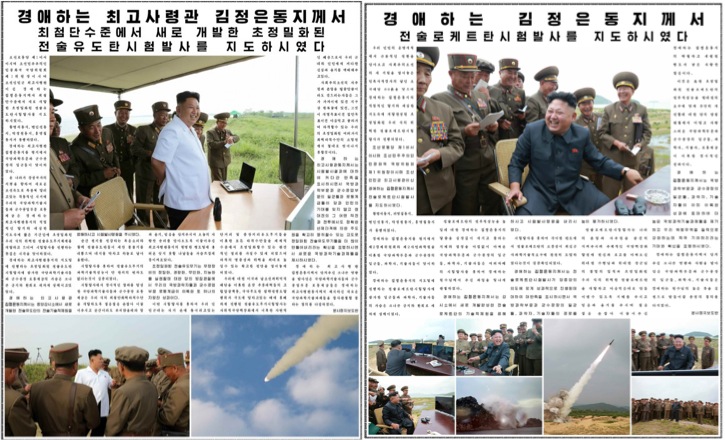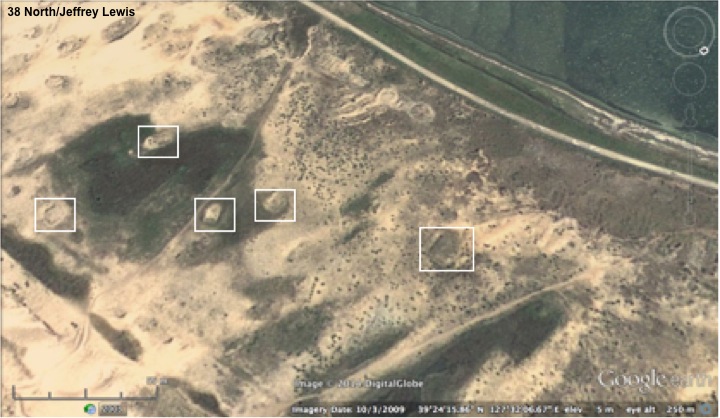Don’t Know Where Waldo Went, But Kim Jong Un Was in Wonsan: Geolocating North Korea’s June 26 and August 14 Missile Launches
On at least two occasions this year, North Korea has tested what it describes as an “ultra precision” tactical missile.
- On June 26, 2014, North Korea launched two “newly developed cutting-edge ultra-precision tactical guided missiles.” Kim Jong Un attended the launch.
- On August 14, 2014, North Korea again tested “an ultra-precision high-performance tactical rocket of Korean style.” Kim was in attendance. The ROK military stated that North Korea fired five missiles 220 km.

Images of the August 14 test, released by KCNA and Rodong Sinmun, suggest the new missile may be an extended-range version of the Soviet SS-21 Tochka surface-to-surface missile.
The SS-21 Scarab is a solid-fueled tactical missile developed by the Soviet Union in the 1970s to replace the Frog-7 rocket artillery system. The SS-21 represented a significant improvement in accuracy over the Frog. The Soviet Union planned to use the more accurate SS-21 for precision strikes against tactical targets such as command posts and airfields. The SS-21 is normally armed with a fragmentation warhead using conventional explosives, but the SS-21 could also be armed with nuclear, chemical or biological warheads. In 1983-1984, the Soviet Union supplied SS-21 launches and missiles to Syria. The US calls the North Korean version of the missile the KN-02 Toksa. (For the best review of the KN-02, see Joseph S. Bermudez Jr., “The KN-02 SRBM,” KPA Journal, February 2010.)
Images, of course, can be altered. Photo analysis tools have demonstrated that some past images released by KCNA have been altered but analysis of these pictures using the open source tool FotoForensics does not reveal obvious evidence of tampering. Still caveat lector!
Using images published by KCNA and Rodong Sinmun I was able to locate both the launch site of the August 14 test, which was northeast of Wonsan, as well as the impact area 220 km further northeast, confirming reports that the missile traveled that distance.
Moreover, the June 26 launch appears to have occurred from a nearby location—although the geolocation is not as strong as it is for the August 14 test. It is no surprise that Pyongyang is conducting a series of tests of its new missile from this location. Defectors have long stated that Wonsan is home to a missile facility. The launch area contains a number of revetments for rocket and missile launchers. Moreover, there are a number of nearby sites that appear to be housing for instrumentation, such as radars, to observe missile tests. These structures suggest that this is probably a short-range ballistic missile range-head.
Geolocating the August 14 Test
A photo showing what appear to be two islands behind Kim Jong Un, as well as other features, demonstrate that the launch occurred in the vicinity of: 39 24 06N, 127 32 13E. The “islands” contain unique clusters of buildings that can be matched to satellite imagery. An additional detail, which will be discussed later, is the presence of a road running behind Kim’s party. Although the road is not visible in the image, the utility poles that run along it are.
Figure 1. Locating the probable launch site.

A close examination of this area reveals a number of revetments (marked in white boxes) for missile and artillery rocket launchers. This site would appear to be a normal location for DPRK tests of short-range missiles systems like the SS-21.
Figure 2. Revetments for launchers at the probable launch site.

ROK military sources told Yonhap the missile traveled 220 km. KCNA released two images of the impact point—one a still image and another of Kim Jong Un in front of a computer with what appears to be live video of the target.
Two-hundred twenty kilometers northeast of the launch site, there is a rock outcropping located at 40 38 48N, 129 32 58E that matches the images of the impact site; the rock formations are identical.
Figure 3. Locating the probable impact point.

Geolocating the June 26 Launch
Although the images released for the June 26 launch are fewer and harder to geolocate, the available evidence tends to suggest the launch probably took place from the same location as the test on August 14.
Both launches, according to ROK military sources quoted by Yonhap, occurred from the area around Wonsan. The coastline, utility poles and other features strong suggest that the two sites are close to one another.
In both photographs, Kim’s party is shown at a makeshift observation point with the water behind them. Because the launch went out to sea and the coast appears to curve behind Kim in both images, he is most likely standing on an isthmus—with water in front and behind. This is a rather unusual geographic feature around Wonsan.
Figure 4. Similar scenery around both observation sites.

The difference appears to be that in the June 26 image, Kim’s party is viewing the launch from an area between the road and the water, while on August 14, the road was behind them. Although the low-set road is not visible in either image, in both cases we can see its location based on the utility poles that run along it.
Figure 5. Utility poles mark the presence of a road.

Although the evidence for the second location is not as strong as the first, on balance, it tends to suggest the locations are likely the same. Given the similarities in DPRK media coverage of the launches, there is reason to seriously consider the possibility that the “ultra precision” missile test on June 26 was also an extended-range SS-21.
Conclusion
The location of the August 14 test confirms that the missile traveled 220 km. If it is an SS-21 derived missile, then North Korea has extended the range considerably from the original Soviet system supplied to countries such as Syria. The tests naturally raise the questions about when such a missile will become operational and, perhaps more importantly whether North Korea will develop a new series of long-range ballistic missiles based on the solid-fueled SS-21. Solid-fueled missiles are far more survivable than missiles that use liquid propellant, which must be pumped into the missile before launch.
It seems certain that more tests will follow. Writing in response to the condemnation of North Korea’s pace of missile testing in 2014, KCNA carried a commentary by Kim In Yong of the “Rocket Research Institute of the Korean Second Natural Science Academy,” promising that “More fresh type ultra-precision latest rocket test-fire will be conducted soon in succession.” On September 1, North Korea tested another missile to a similar range, possibly of the same type, this time from Chaggang.
The most recent test would bring the number of what the ROK now calls “novel tactical missiles” tested to eight, with more tests sure to come. That’s a cheery thought. Well, at least we can look forward to geolocating more missile tests.
Jeffrey Lewis is Director of the East Asia Nonproliferation Program at the James Martin Center for Nonproliferation Studies (CNS), Monterey Institute of International Studies, and a frequent contributor to 38 North.
